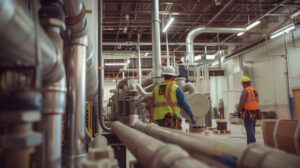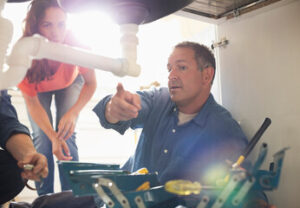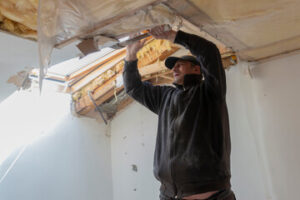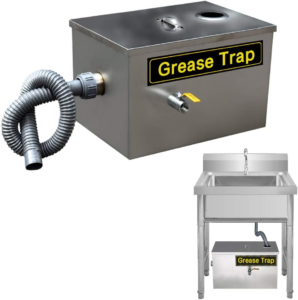The plumbing division of the construction industry is more complex than many people realize. From residential to commercial, there are key differences in the design and installation of plumbing systems that must be understood.
Proper plumbing installation and maintenance prevent issues like leaks, low water pressure, and clogged drains. Akron Plumber also helps ensure compliance with environmental standards and energy efficiency.

What’s The Difference Between Residential And Commercial Plumbing?
Residential plumbing focuses on the installation, maintenance, and repair of piping systems and fixtures in homes. Commercial plumbing, on the other hand, deals with larger buildings and facilities that are used by many people daily. This means that they have to cope with more wear and tear, and any problems are going to be more catastrophic than in a home.
Commercial spaces also require more outlets and pipes for sinks and toilets, as well as larger water pressure to accommodate the higher usage. This can make it harder to diagnose and fix plumbing issues, as the piping may be more complicated and have multiple components. In addition, it can be difficult to locate a leak in a large building, such as a skyscraper, that has multiple floors and miles of pipes. This can lead to huge water bills and costly repairs.
What’s The Difference Between Commercial And Industrial Plumbing?
A commercial plumbing system is used in offices, malls, high-rise buildings, and more. These systems are used by more people than residential plumbing systems, which means they take on greater wear and tear over time.
This constant, heavy usage increases the risk of damage. Something as simple as a broken pipe can be devastating to a business. Having an expert plumber that understands the ins and outs of commercial plumbing is essential.
Industrial plumbing serves the specialized needs of industrial facilities such as factories, warehouses, and manufacturing plants. These systems are designed to transport large volumes of water, chemicals, and other fluids. They also must abide by strict regulations and safety standards set by government agencies. This requires specialized equipment and more complex piping networks.
What’s The Difference Between Commercial And Retail Plumbing?
Commercial plumbing involves the installation and repair of larger plumbing systems in business premises, large housing complexes, and other non-residential spaces. This is a specialized field that requires expert knowledge, adherence to stringent regulations, and extensive experience.
Many businesses have different requirements, such as restaurants needing grease traps or hospitals requiring hygienic water systems. Commercial plumbers are also likely to work outside of normal business hours and must have specific insurance coverage.
Additionally, commercial plumbing often consists of more complicated fixtures than those found in homes, such as urinals and toilets, which are designed for higher volumes of waste. These fixtures are also designed to prevent clogs and have features that make them easy to clean and drain. Similarly, commercial sinks and faucets are typically larger to handle the higher volume of usage. As such, these features need to be more durable than standard household ones.
What’s The Difference Between Commercial And Hospital Plumbing?
A commercial plumber works with larger plumbing systems in business premises and other non-residential properties. These include offices, hotels, shopping centers, restaurants, and more. These systems typically have bigger pipes and can handle more usage than residential plumbing.
Commercial plumbers must also know how to deal with different building codes. For example, hospitals have their own set of requirements that differ from other businesses. And if you’re working on a multi-story building, you need to consider how gravity affects water pressure.
Additionally, commercial plumbers often work outside of regular business hours. This is because they need to ensure that business operations are not disrupted while addressing plumbing issues. They also need to be prepared for emergencies. This means they need to be equipped with the right tools and materials to respond quickly. Also, they may need to coordinate with other tradespeople and architects to ensure that all the building’s plumbing requirements are met.
What’s The Difference Between Commercial And Restaurant Plumbing?
Leaky taps and clogged drains are problems that can impact anyone, but they’re especially dangerous in commercial spaces where people work. They can lead to lost productivity, expensive repairs, and even serious health and safety issues.
Plumbing systems in commercial settings have to be bigger and more complex than residential ones, and they’re also subject to stricter regulations and codes. Look for a plumber who has experience working in commercial environments, and make sure they can provide emergency services around the clock. Commercial kitchens require more exotic fixtures, like industrial dishwashers and waste grinders. They also need to accommodate high-volume usage and be compatible with a variety of temperatures.
What’s The Difference Between Commercial And Office Plumbing?
Commercial plumbing is the installation, repair, and maintenance of plumbing systems found in office buildings, malls, high rises, retail spaces, healthcare facilities, food establishments, and much more. These are larger-scale, complex plumbing systems that need to adhere to stricter building codes and manage a higher volume of usage than residential properties.
These structures typically have multiple floors that need plumbing services, such as toilets and sinks. Many also need larger pipes to handle the higher water demand and ensure sanitary conditions.
As a result, commercial plumbers often work outside of regular business hours to minimize disruptions and keep businesses running smoothly. They also need to understand and be able to follow detailed plans and specifications when installing plumbing. These skills are essential to managing large, complex plumbing projects and ensuring the safety of occupants. The risk level for commercial plumbers is therefore higher than with residential jobs.
What’s The Difference Between Commercial And Hotel Plumbing?
While the basic plumbing skills are the same, commercial plumbers must have a wider knowledge of building plans and designs to install complex water systems in multiple-story buildings such as hotels and apartments. They are also responsible for designing and installing water heating infrastructure, pipework, fire sprinklers, ventilation systems, and more.
Commercial plumbing serves a lot more people than residential systems, so the pipes are bigger and there are more sinks and toilets. Additionally, many businesses have to meet strict health codes, so they need different plumbing fixtures that can be easily cleaned and drained.
You will want a commercial plumber who is experienced in working on large-scale plumbing projects, adheres to the highest industry standards, and can quickly procure permits to complete jobs efficiently. Ask potential plumbers for references from previous clients and pay attention to their online reviews.
What’s The Difference Between Commercial And Healthcare Plumbing?
The plumbing systems in hospitals and other healthcare facilities are often more complex than those in commercial spaces like office buildings or restaurants. This is because these spaces need to comply with stringent healthcare regulations and must be easy to clean.
This type of work also involves more risk, which means that plumbers working in these spaces should have significant insurance and be bonded. They may also have to go through a bidding process to be chosen for the job.
Additionally, plumbers need to understand the unique requirements and maintenance issues that are associated with healthcare plumbing. This includes understanding the importance of proper hand hygiene and the need for disinfection of medical equipment. This is because bacteria can be transmitted through water and may cause illness in patients. This knowledge can help them design plumbing systems that meet these demands.
What’s The Difference Between Commercial And Education Plumbing?
Plumbing programs offer students a comprehensive education in the field and prepare them for future careers. They cover topics like pipe sizing, soldering and brazing, blueprint reading, water distribution systems, emergency repairs, and more. They also include apprenticeship programs that provide students with hands-on experience in real-world settings.
Commercial plumbing involves larger-scale installations and more complex regulations and codes than residential systems. It also requires a more thorough understanding of industrial-grade pipes and fixtures, as well as specialized knowledge for specific industries, such as restaurants or hospitals.
Additionally, commercial plumbing relies on preventative maintenance to avoid large-scale issues. This can lead to higher income potential for plumbers, as well as more consistent work opportunities. This is particularly true if the plumber is part of a union, which offers benefits such as negotiated rates and priority scheduling.
What’s The Difference Between Commercial And Agriculture Plumbing?
Commercial horticulture, indoor farming operations, and field growing operations all require specialized plumbing services. The experts can provide agricultural plumbing services for all facets of your operation. This includes consultation, design services for the new era of irrigation systems in both indoor and outdoor agriculture facilities, and more.
Commercial plumbing involves larger pipe diameters and higher water pressure systems than residential systems. It also requires specialized tools and equipment to handle. Commercial plumbing also typically connects to sewage systems, which means more issues can occur than with plumbing in private homes.
Commercial plumbing also places a greater emphasis on water efficiency and conservation. For example, commercial plumbing can include backflow prevention systems that keep polluted water from flowing back into the public water system. This can help reduce utility costs and protect the environment.








